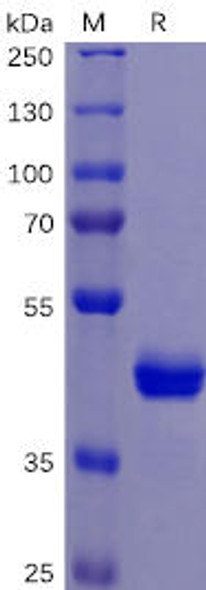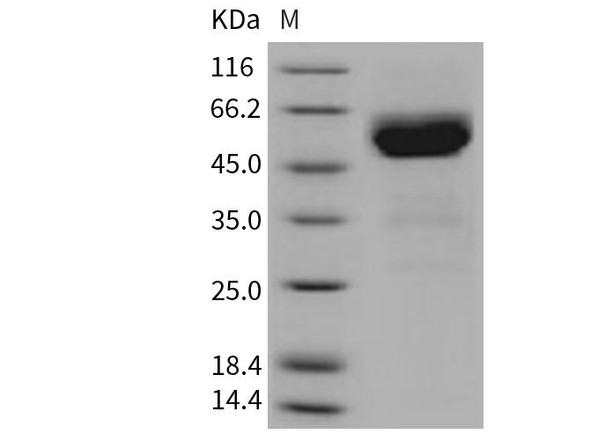Description
| Product Name: | Human TNFRSF10B Recombinant Protein |
| Product Code: | RPPB1026 |
| Size: | 50µg |
| Species: | Human |
| Target: | TNFRSF10B |
| Synonyms: | Tumor necrosis factor receptor superfamily member 10B, Death receptor 5, TNF-related apoptosis-inducing ligand receptor 2, TRAIL receptor 2, TRAIL-R2, CD262, TNFRSF10B, DR5, KILLER, TRAILR2, TRICK2, ZTNFR9, TRICKB, TRICK2A, TRICK2B, KILLER/DR5. |
| Source: | Escherichia Coli |
| Physical Appearance: | Sterile Filtered White lyophilized (freeze-dried) powder. |
| Formulation: | Lyophilized from a 0.2�m filtered concentrated solution in PBS, pH7.4. |
| Solubility: | It is recommended to reconstitute the lyophilized TNFRSF10B in sterile 18M-cm H2O not less than 100�g/ml, which can then be further diluted to other aqueous solutions. |
| Stability: | Lyophilized TNFRSF10B although stable at room temperature for 3 weeks, should be stored desiccated below -18°C. Upon reconstitution TNFRSF10B should be stored at 4°C between 2-7 days and for future use below -18°C. For long term storage it is recommended to add a carrier protein (0.1% HSA or BSA).Please prevent freeze-thaw cycles. |
| Purity: | Greater than 95.0% as determined by�SDS-PAGE. |
| Amino Acid Sequence: | ESALITQQD LAPQQRVAPQ QKRSSPSEGL CPPGHHISED GRDCISCKYG QDYSTHWNDL LFCLRCTRCD SGEVELSPCT TTRNTVCQCE EGTFREEDSP EMCRKCRTGC PRGMVKVGDC TPWSDIECVH KES |
| Biological Activity: | The TNFRSF10B reduced the production of LPS-induced TNF by its ability to neutralize endogenous TRAIL in fresh human PBMC. In this assay, endogenous TRAIL is induced during a 24 hour exposure to LPS (10ng/mL) but in the presence of TNFRSF10B, TRAIL-induced TNF is suppressed. |
TRAIL Receptor-1 (DR4) and TRAIL Receptor-2(DR5) are members of the TNFR superfamily of transmembrane proteins and contain a cytoplasmic "death domain", which is capable of activating the cell's apoptotic machinery. These receptors are activated by binding to either membrane anchored or soluble TRAIL/Apo2L.
TNFRSF10B Human Recombinant produced in E.Coli is a single, non-glycosylated, polypeptide chain containing 132 amino acids and having a molecular mass of 14.8kDa.The TNFRSF10B is purified by proprietary chromatographic techniques.
| UniProt Protein Function: | TRAIL-R2: Receptor for the cytotoxic ligand TNFSF10/TRAIL. The adapter molecule FADD recruits caspase-8 to the activated receptor. The resulting death-inducing signaling complex (DISC) performs caspase-8 proteolytic activation which initiates the subsequent cascade of caspases (aspartate-specific cysteine proteases) mediating apoptosis. Promotes the activation of NF- kappa-B. Homotrimer. Can interact with TRADD and RIPK1. Regulated by p53/TP53. Widely expressed in adult and fetal tissues; very highly expressed in tumor cell lines such as HeLaS3, K-562, HL-60, SW480, A-549 and G-361; highly expressed in heart, peripheral blood lymphocytes, liver, pancreas, spleen, thymus, prostate, ovary, uterus, placenta, testis, esophagus, stomach and throughout the intestinal tract; not detectable in brain. 3 isoforms of the human protein are produced by alternative splicing. |
| UniProt Protein Details: | Protein type:Motility/polarity/chemotaxis; Membrane protein, integral Chromosomal Location of Human Ortholog: 8p22-p21 Cellular Component: integral to membrane; plasma membrane Molecular Function:protein binding; TRAIL binding; receptor activity Biological Process: regulation of apoptosis; caspase activation; cell surface receptor linked signal transduction; positive regulation of I-kappaB kinase/NF-kappaB cascade; induction of apoptosis via death domain receptors; apoptosis; activation of NF-kappaB-inducing kinase Disease: Squamous Cell Carcinoma, Head And Neck |
| NCBI Summary: | The protein encoded by this gene is a member of the TNF-receptor superfamily, and contains an intracellular death domain. This receptor can be activated by tumor necrosis factor-related apoptosis inducing ligand (TNFSF10/TRAIL/APO-2L), and transduces an apoptosis signal. Studies with FADD-deficient mice suggested that FADD, a death domain containing adaptor protein, is required for the apoptosis mediated by this protein. Two transcript variants encoding different isoforms and one non-coding transcript have been found for this gene. [provided by RefSeq, Mar 2009] |
| UniProt Code: | O14763 |
| NCBI GenInfo Identifier: | 313104032 |
| NCBI Gene ID: | 8795 |
| NCBI Accession: | O14763.2 |
| UniProt Secondary Accession: | O14763,O14720, O15508, O15517, O15531, Q6UXM8, Q7Z360 Q9BVE0, |
| UniProt Related Accession: | O14763 |
| Molecular Weight: | |
| NCBI Full Name: | Tumor necrosis factor receptor superfamily member 10B |
| NCBI Synonym Full Names: | tumor necrosis factor receptor superfamily, member 10b |
| NCBI Official Symbol: | TNFRSF10B�� |
| NCBI Official Synonym Symbols: | DR5; CD262; KILLER; TRICK2; TRICKB; ZTNFR9; TRAILR2; TRICK2A; TRICK2B; TRAIL-R2; KILLER/DR5�� |
| NCBI Protein Information: | tumor necrosis factor receptor superfamily member 10B; Fas-like protein; death receptor 5; cytotoxic TRAIL receptor-2; TNF receptor superfamily member 10b; apoptosis inducing receptor TRAIL-R2; apoptosis inducing protein TRICK2A/2B; TNF-related apoptosis-inducing ligand receptor 2; death domain containing receptor for TRAIL/Apo-2L; tumor necrosis factor receptor-like protein ZTNFR9; p53-regulated DNA damage-inducible cell death receptor(killer) |
| UniProt Protein Name: | Tumor necrosis factor receptor superfamily member 10B |
| UniProt Synonym Protein Names: | Death receptor 5; TNF-related apoptosis-inducing ligand receptor 2; TRAIL receptor 2; TRAIL-R2; CD_antigen: CD262 |
| UniProt Gene Name: | TNFRSF10B�� |
| UniProt Entry Name: | TR10B_HUMAN |










